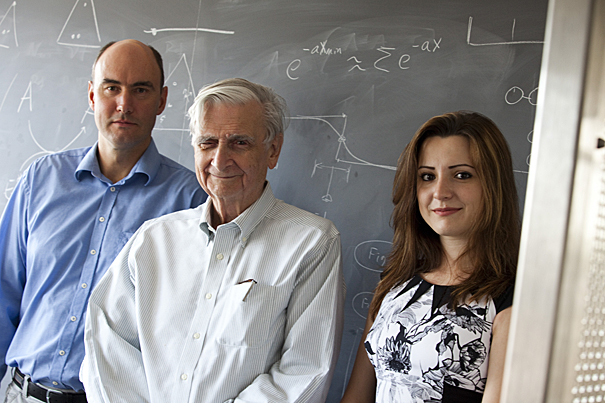
Mathematical biologists Martin A. Nowak (from left) and Corina E. Tarnita and evolutionary biologist E.O. Wilson presented a new theory on the evolution of eusociality, the rare but spectacularly successful social structure in which individuals of the world’s most dominant species cooperate to raise offspring.
Stephanie Mitchell/Harvard Staff Photographer
The ties that bind
Paths by which creatures put needs of group ahead of their own
Scientists at Harvard University have sketched a new map of the “evolutionary labyrinth” that species must traverse to reach “eusociality,” the rare but spectacularly successful social structure in which individuals of the world’s most dominant species cooperate to raise offspring.
Mathematical biologists Martin A. Nowak and Corina E. Tarnita and evolutionary biologist Edward O. Wilson presented their work in the latest edition of the journal Nature, for release Aug. 25. Their modeling showed that the straightforward theory of natural selection alone can explain the evolution of eusocial behavior, without the need for “kin selection” theory, which is based on the concept of inclusive fitness, wherein a creature puts the needs of its close relatives ahead of its own.
“The empirical evidence gathered in our paper demonstrates that eusociality is exceedingly rare because species must navigate a lengthy evolutionary labyrinth to reach this state,” said Wilson, the Pellegrino University Professor Emeritus at Harvard. “We hope our new theory for the evolution of eusociality will open up sociobiology to new avenues of research by liberating the study of social evolution from mandatory adherence to kin selection theory. After four decades ruling the roost, it is time to recognize this theory’s very limited prowess.”
Eusocial organisms, such as ants, wasps, and bees, form hierarchical social systems with reproductive queens and sterile workers, meaning that many individuals take the evolutionarily counterintuitive step of sacrificing their own reproduction to care for the offspring of others. Kin selection theory, which supports tight genetic ties in such behavior, has been the major theoretical attempt to explain the evolution in such directions.
“In some situations, inclusive fitness theory, which tries to calculate fitness effects conferred on relatives, is a suitable alternative to standard population genetics,” said Nowak, professor of mathematics and of biology and director of the University’s Program for Evolutionary Dynamics. “But it is not applicable in general. Our analysis shows that inclusive fitness theory rests on fragile assumptions, which rarely hold in nature.”
“Contrary to many previous claims, we prove that inclusive fitness theory is not an extended theory of evolution and is not needed to explain eusociality,” Nowak said. “Standard natural selection theory represents a simpler and superior approach, and provides an exact framework for interpreting empirical observations.”
Eusociality is rare, but important in evolutionary biology because the few species that adhere to it — including social insects and, to an extent, humans — rank among the planet’s most dominant. The biomass of ants alone is more than half of all insects, exceeding that of all terrestrial nonhuman vertebrates combined. Humans, who are more loosely eusocial, dominate land vertebrates.
“Eusociality has arisen independently some 10 to 20 times in the course of evolution,” said Tarnita, a junior fellow in Harvard’s Society of Fellows. “Our model shows that it is difficult to get eusociality in the first place, but that it is very stable once it is established. A colony behaves like a ‘superorganism,’ reproducing the genome of the queen and the sperm she has stored.”
Nowak, Tarnita, and Wilson’s proposal on eusocial evolution sketches out three distinct steps species can take to sidestep eusociality’s evolutionary cost:
- First, species must form groups within a population, such as when nests or food attract individuals to discrete locations some distance apart, when parents and offspring remain together, or when migrating flocks follow leaders.
- Second, species must accumulate traits, arising through ordinary natural selection, that favor the switch to eusociality. For instance, Ceratina and Lasioglossum bees, which appear perched on the cusp of eusociality, cooperate in foraging, tunneling, and guarding resources. Another such pre-adaptation is progressive provisioning, in which a female builds a nest, lays an egg in it, and then feeds or guards larvae until they mature. Most importantly, the candidate species must build a defensible nest.
- Finally, individuals must develop genes supporting eusociality, whether by mutation or recombination. Crossing the threshold to eusociality essentially requires that a female and her offspring not disperse to start new, individual nests, but rather remain at the old nest. While eusocial genes have yet to be identified, at least two eusocial ant species are known to have genes that quell the urge to roam from the nest.
If these steps are followed and a species becomes eusocial, the evolutionary costs of individuals forgoing reproduction are compensated by the greatly reduced mortality of the queen and her larvae, which are protected by the colony. In some ant species, a queen that might live for only a few months if alone can live for 25 years or more as part of a colony, producing millions of offspring.
Nowak, Tarnita, and Wilson’s work was funded by the John Templeton Foundation, the National Science Foundation, the National Institutes of Health, the Bill and Melinda Gates Foundation, and J. Epstein.




